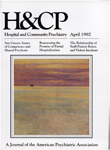The Promise of Partial Hospitalization: A Reassessment
Abstract
In this review of trends in partial hospitalization since 1987, the authors provide a brief overview of the field, summarize recent research findings, examine the data on the growth of partial hospitals, and outline recent changes in public- and private-sector use of this treatment modality. Support for intermediate and long-term partial hospitalization is diminishing rapidly, while support for short-term partial hospitalization as an alternative to inpatient care is increasing in the private sector and diminishing in the public sector. The future for partial hospitals seems uncertain, as the treatment functions of these programs are being assumed by psychosocial and vocational rehabilitation programs and assertive community treatment teams. In light of these trends, the authors recommend new directions for partial hospital research involving comparisons between short-term day hospitalization and intensive outpatient interventions.
Access content
To read the fulltext, please use one of the options below to sign in or purchase access.- Personal login
- Institutional Login
- Sign in via OpenAthens
- Register for access
-
Please login/register if you wish to pair your device and check access availability.
Not a subscriber?
PsychiatryOnline subscription options offer access to the DSM-5 library, books, journals, CME, and patient resources. This all-in-one virtual library provides psychiatrists and mental health professionals with key resources for diagnosis, treatment, research, and professional development.
Need more help? PsychiatryOnline Customer Service may be reached by emailing [email protected] or by calling 800-368-5777 (in the U.S.) or 703-907-7322 (outside the U.S.).



